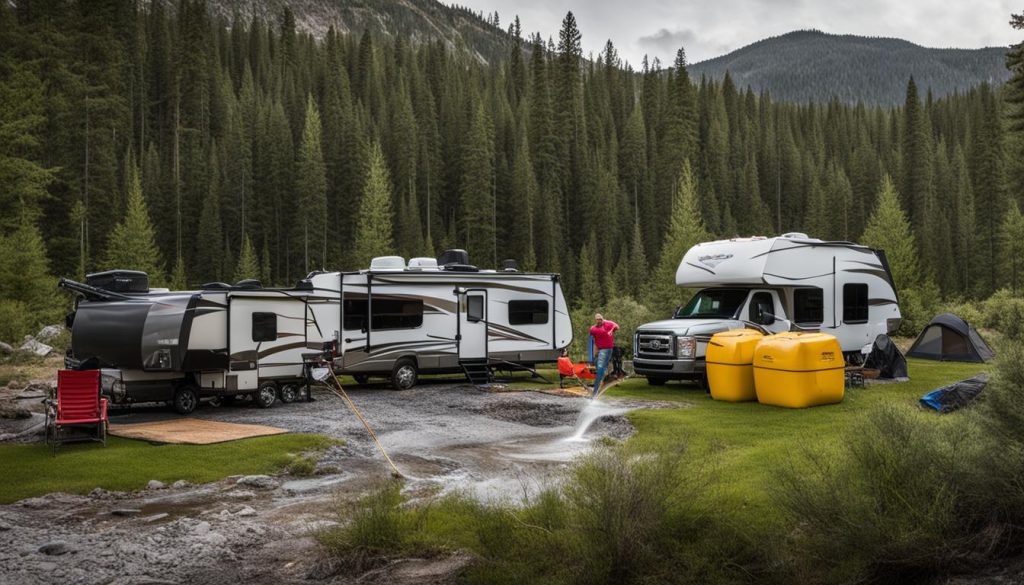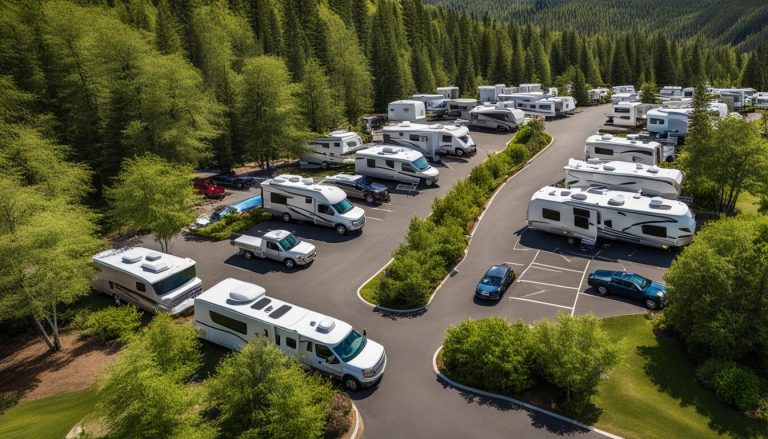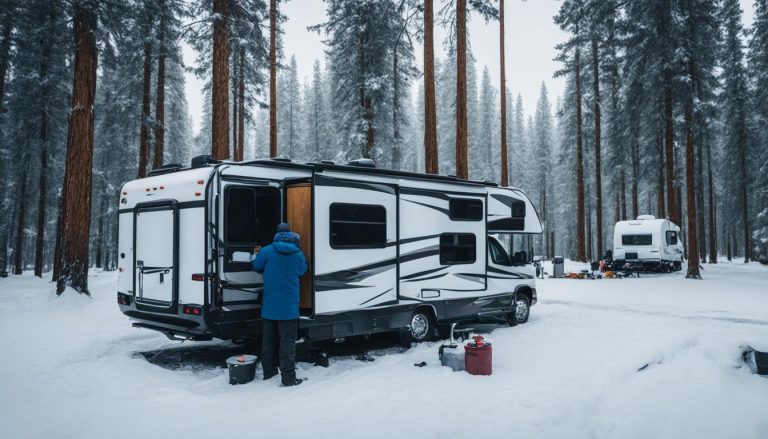RV Maintenance: How to Clean RV Black Tank Easily
gorvlifestyle.com and its partners may earn a commission if you purchase a product through one of our links
Cleaning your RV’s black tank is an essential part of RV maintenance. Neglecting to clean it regularly can result in unpleasant odors and malfunctioning tank sensors. To keep your black tank clean and functioning optimally, it’s recommended to perform a deep clean at least twice a year. This can be done using a bacteria-based cleaner such as Unique Clean-It. The process involves filling the tank with water, adding the cleaner, letting it sit for 12-72 hours, and then thoroughly rinsing the tank. Using this method, you can effectively remove built-up waste and eliminate odors from your RV’s black tank.
Key Takeaways:
- Regular deep cleaning of your RV’s black tank is crucial to prevent odors and sensor issues.
- Perform a deep clean at least twice a year using a bacteria-based cleaner like Unique Clean-It.
- Fill the tank with water, add the cleaner, let it sit, and then thoroughly rinse the tank.
- Deep cleaning removes built-up waste and eliminates odors from the black tank.
- Maintain your black tank by properly managing tank valves and using RV-safe toilet paper.
Tips for Maintaining RV Black Tanks
In addition to regular deep cleaning, there are several tips and techniques that can help maintain your RV’s black tank. By following these guidelines, you can ensure that your black tank stays clean and functions optimally throughout your travels.
1. Keep the tank filled
One important tip for maintaining your RV’s black tank is to keep it filled with at least 5 gallons of water while traveling. This helps prevent the build-up of waste and keeps the tank from drying out. Simply add water to the tank before hitting the road, and make sure to maintain the water level throughout your trip.
2. Use ice for cleaning
An effective cleaning hack for your black tank is to add a bag of ice before you start your journey. As you drive, the ice will slosh around and help break down any residue or waste that might be clinging to the tank walls. This can aid in the overall cleanliness of the tank and make it easier to empty.
3. Flush only the right materials
When it comes to emptying your RV’s black tank properly, it’s crucial to flush only digested materials and RV-safe toilet paper down the toilet. Flushing other items such as wipes or sanitary products can lead to blockages in the plumbing system and cause unnecessary problems.
4. Avoid harsh chemicals
While it may be tempting to use strong chemicals or bleach to clean your RV’s black tank, it’s best to avoid them. Harsh chemicals can damage the tank and seals, leading to leaks and costly repairs. Instead, opt for bacteria-based cleaners specifically designed for RV black tanks.
5. Properly manage tank valves
To ensure effective emptying of the black tank, it’s important to properly manage the tank valves. Keep the valves closed until the tank is more than half full to prevent drying out. This will allow for a more thorough and efficient emptying process when it’s time to dump the tank.
By following these maintenance tips and incorporating them into your RV black tank care routine, you can keep your tank clean, odor-free, and functioning properly throughout your travels.
How to Clean RV Gray Water Tanks
Cleaning the gray water tank of your RV is crucial for maintaining a fresh and odor-free environment. Gray tanks can accumulate soap scum, food grease, lotions, and other debris, resulting in unpleasant smells and inaccurate sensor readings. Follow these effective RV gray tank cleaning techniques to keep your tank in optimal condition.
RV Gray Tank Cleaning Tips
- Regularly flush the gray water tank to prevent buildup. It is recommended to clean the tank at least once a month.
- Use a grease-eating dish soap, such as Dawn Ultra, to deep clean the gray tank.
- Fill the tank with water and add the dish soap.
- Let the solution sit overnight to break down grease and residue.
- Thoroughly rinse the tank to remove the soap and debris.
RV Gray Tank Cleaning Products
There are various RV gray tank cleaning products available in the market that can help you effectively clean your gray water tank. These products are specifically formulated to remove grease, soap scum, and other debris. Some popular RV gray tank cleaning products include:
| Product | Description |
|---|---|
| Thetford RV Drain Valve Lubricant | A lubricant that helps prevent waste buildup and ensures smooth operation of the tank valves. |
| Camco TST Max Strength RV Toilet Treatment | A powerful treatment that eliminates odor and breaks down waste in both black and gray tanks. |
| Happy Campers Organic RV Holding Tank Treatment | An eco-friendly treatment that breaks down waste and controls odors without the use of harsh chemicals. |
These products can enhance your RV gray tank cleaning routine and contribute to a more pleasant RVing experience.
Remember to always follow the instructions provided by the manufacturer when using cleaning products.
Maintaining Combo Tanks
Combo tanks, which serve as both black and gray water tanks, require specific maintenance practices to ensure optimal performance and prevent unpleasant odors. Whether you use your combo tank solely for black water or gray water, or both, here are some essential tips for maintaining your RV combo tank:
1. Proper Valve Management
Keep the tank valves closed when not in use to prevent drying out and maintain a seal between the tank and the plumbing system. This helps to prevent leaks and odors from seeping into your RV.
2. Regular Deep Cleaning
Performing regular deep cleaning of your combo tank is essential for proper sanitation and odor prevention. Use a bacteria-based cleaner specifically designed for RV tanks, such as Clean-It, to effectively remove built-up waste and eliminate odors.
3. Cleaning Tips Based on Usage
If you use your combo tank solely for black water, follow the steps for cleaning an RV black water tank. If you use it solely for gray water, apply the process for cleaning an RV gray water tank.

| Type of Use | Maintenance Steps |
|---|---|
| Black Water Only | Follow the steps for cleaning an RV black water tank |
| Gray Water Only | Apply the process for cleaning an RV gray water tank |
| Both Black and Gray Water | Regular deep cleaning with a bacteria-based cleaner |
By following these maintenance tips, you can ensure that your RV combo tank remains clean, odor-free, and in optimal working condition for your outdoor adventures.
Additional Tips for RV Tank Cleaning and Maintenance
In addition to regular deep cleaning, there are a few additional tips for maintaining your RV’s tanks. One effective way to stay organized and keep track of your RV maintenance and repairs is by using an online tool like RV LIFE Maintenance. This tool not only helps you stay organized but also provides timely reminders for essential maintenance tasks, ensuring that you never miss a step in keeping your tanks in top condition.
Another important aspect of tank maintenance is using RV-specific toilet paper. Ordinary toilet paper can cause clogs in the plumbing system, potentially leading to expensive repairs. By using RV-specific toilet paper, you can prevent clogs and keep your tanks running smoothly.
When it comes to cleaning your tanks, it’s always considerate to perform the deep cleaning process at a campground or empty dump station. This way, you can avoid inconveniencing other RVers while ensuring that your tanks are thoroughly cleaned and ready for your next adventure.
Lastly, storing your RV with clean tanks and following proper maintenance practices is crucial for the longevity of your tanks. By maintaining clean tanks and following best practices for RV tank maintenance, you can ensure that your tanks are in good working condition, ready for your next excursion.
FAQ
How often should I deep clean my RV’s black tank?
It is recommended to perform a deep clean at least twice a year to keep your black tank clean and functioning optimally.
What is the best product to use for cleaning an RV’s black tank?
A bacteria-based cleaner such as Unique Clean-It is effective for deep cleaning the RV’s black tank.
How do I deep clean my RV’s black tank?
To deep clean the black tank, fill it with water, add the bacteria-based cleaner, let it sit for 12-72 hours, and then thoroughly rinse the tank.
What can I do to maintain my RV’s black tank?
Keeping at least 5 gallons of water in the tank while traveling, adding a bag of ice before traveling, and only flushing digested materials and RV-safe toilet paper can help maintain the black tank.
Can I use harsh chemicals or bleach to clean my RV’s black tank?
No, harsh chemicals and bleach should never be used in the RV’s plumbing system, as they can damage the tank and seals.
How should I manage the tank valves for effective emptying?
Keep the tank valves closed until they are more than half full to prevent drying out and ensure effective emptying of the tank.
How do I clean my RV’s gray water tank?
To deep clean the gray tank, fill it with water, add grease-eating dish soap such as Dawn Ultra, let it sit overnight, and then thoroughly rinse the tank.
How should I maintain combo tanks that serve both black and gray water?
If you use your combo tank solely for black water, follow the steps for cleaning an RV black water tank. If you use it solely for gray water, follow the steps for cleaning an RV gray water tank. For combo tanks used for both, keep the tank valves closed when not in use and perform regular deep cleaning with a bacteria-based cleaner.
Are there any additional tips for maintaining RV tanks?
Using an online tool like RV LIFE Maintenance to track maintenance, using RV-specific toilet paper, avoiding flushing wipes or sanitary products, performing deep cleaning at a campground or dump station, and storing the RV with clean tanks are some additional tips for maintaining RV tanks.






